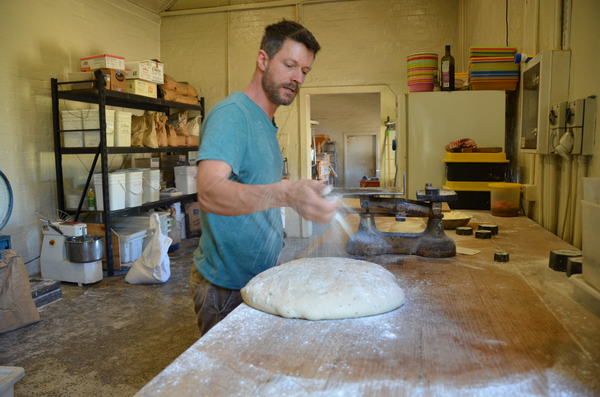Chance encounters set James Fisher on the path to setting up Cannibal Creek Bakehouse.
He came across Richard Bertinet’s Dough on his sister-in-law’s bookshelf during a trip to the UK and fell in love with baking bread, and discovered the 120-year-old oven he now uses in Garfield through a mate and work associate.
He was meeting with Ken about the idea of setting up a community bakery when a woman Ken’s kids went to childcare with stopped by.
She said ‘it’s funny you’re doing this, because I’ve got an old oven and no one’s really using it’ and the lease was coming up.
“I came around and had a look at it and it was perfect,” James said.
“There are only six ovens like this that are in a commercial operation in Victoria. It was a real find.
“It’s way more economical than using gas or electric to run an oven.
“The wood that I use comes out of plantations and it’s the by-product of the forestry industry.”
James said even his earliest, messy loaves were still head and shoulders above what he could buy.
“What I started learning about was the effect that other bread has on your system,” he said.
“I wasn’t willing to feed my kids that stuff anymore.”
He was coaching people in middle management and his contract was coming to an end, so he decided to turn his hobby into a career.
“I started a business teaching other people how to make bread for little Johnny,” he said.
“A year into that, I met up with Ken and found this place.
“Things really did just sort of float together.
“Finding this place was such a unique opportunity.”
Today he bakes 150 to 250 loaves in a day, three times a week.
Each one takes at least eight hours to produce, from mixing the ingredients together to taking it out of the oven.
He sells 60 to 70 per cent at farmers’ markets – Akoonah Park in Berwick every Sunday and Cockatoo, Beaumaris, Traralgon and Warragul on alternating Saturdays.
He sells a small amount through his Main Street store and has strong wholesale demand.
It was mostly through trial and error that James learnt how to harness the store’s oven.
“I put in two small fires every time I bake instead of one big one,” he said.
“They’re built for one massive fire.
“When this was built 120 years ago, they only had two kinds of bread – brown bread and white bread and they came in tins and that’s it.
“I’d heard a rumour that the lollypop man in Emerald used to work a scotch oven, so I got in touch with him.
“I got in touch with John, who runs the bakery in Trentham.
“It was a lot easier than I thought. It’s a very forgiving oven, easier than a domestic oven, I think.
“I spent the first few years learning how to be a commercial baker before I had the available head space to teach workshops again.
“It’s something I really love doing.
“I think the workshops are a highlight of what we do here.
“There’s a lot of love and a lot of energy that goes into those workshops.
“They’re the start of something.
“I know because they’re coming back and seeing me at the market and they’re not buying bread anymore, I’m bringing bags of flour for them.
“They’re sending me pictures of the bread they’re making and asking me for advice.”
James teaches people how to make their own starter, mill flour and bake bread.
“Fresh, stone-milled flour is a living flour, versus the stuff you buy in the supermarket,” he said.
“That’s just dead flour. It’s just carbohydrate.”
He buys his grain from an 87-year-old organic farmer in the Riverina and uses a custom-made Osttiroler Getreidemühlen from the Green family in Germany.
“If you look at the health problems that are affecting the western world, where did it start going wrong?” he said.
“I would say with the invention of the roller mill and the centralisation of milling has a lot to answer for, producing dead flour with no nutritional value.”
The breakthrough meant large mills could stockpile tonnes of flour and distribute it across the country.
“You couldn’t do that with stone-milled flour because by the time it got to the bakeries, it would have started to go rancid,” he said.
He said that 100 years ago, bread accounted for more than 50 per cent of people’s calorie intake.
“We’re still dealing with that,” he said.
“I’m proud to be bringing milling back into the community.
“The grain that we’re using is insanely nutritious.”







